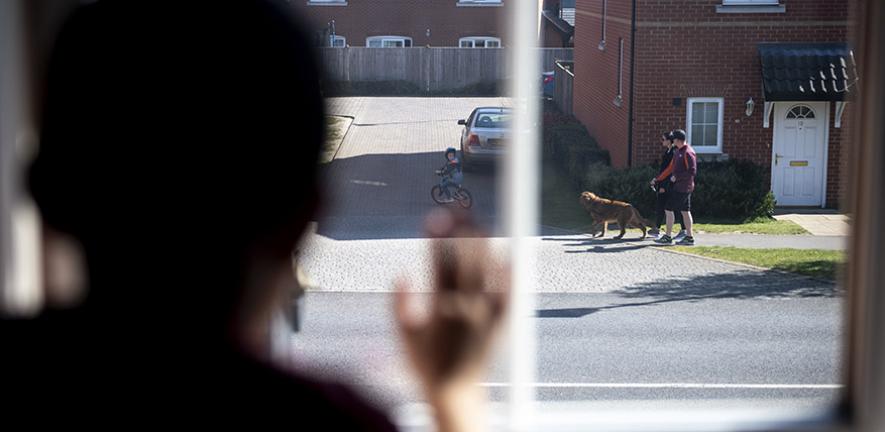
New study is among the first to distinguish effects of the pandemic from effects of lockdown when it comes to wellbeing in Britain.
New study is among the first to distinguish effects of the pandemic from effects of lockdown when it comes to wellbeing in Britain.
Lockdown may be the single most effective action a government can take during a pandemic to maintain psychological welfare
Roberto Foa
The coronavirus outbreak caused life satisfaction to fall sharply, but lockdown went a long way to restoring contentment – even reducing the 'wellbeing inequality' between well-off professionals and the unemployed, according to a new study.
Researchers from Cambridge’s Bennett Institute for Public Policy used a year’s worth of data taken from weekly YouGov surveys and Google searches to track wellbeing in the British population before and during the pandemic.
They say it is one of the first studies to distinguish the effects of the pandemic from those of lockdown on psychological welfare, as it uses week-by-week data, rather than monthly or annual comparisons.
The proportion of Britons self-reporting as 'happy' halved in just three weeks: from 51% just before the UK’s first COVID-19 fatality, to 25% by the time national lockdown began.
This reversed under lockdown, with happiness climbing back to almost pre-pandemic levels of 47% by the end of May. Overall life satisfaction saw a similar drop when the pandemic took hold and a rebound during lockdown.
The study also suggests that while the 'wellbeing inequality' gap remained wide, lockdown started to shrink it: some of the most deprived social groups saw a relative rise in life satisfaction, while the wealthy experienced declines.
“It was the pandemic, not the lockdown, that depressed people’s wellbeing,” said Dr Roberto Foa, from Cambridge’s Department of Politics and International Studies, and Director of the YouGov-Cambridge Centre for Public Opinion Research.
“Mental health concerns are often cited as a reason to avoid lockdown. In fact, when combined with employment and income support, lockdown may be the single most effective action a government can take during a pandemic to maintain psychological welfare.”
Foa had exclusive access to results from the YouGov Weekly Mood Tracker survey, and conducted the study with Bennett Institute colleagues Sam Gilbert and Dr Mark Fabian. The findings are published today on the Institute’s website.
In addition to YouGov data from England, Scotland and Wales, the researchers expanded their study to cover seven other nations – Ireland, the US, Canada, Australia, New Zealand, India and South Africa – using the Google Trends tool.
“By matching survey data with internet searches for mental health topics such as anxiety, depression, boredom and apathy, we were able to compare the UK to a wider set of countries,” said Sam Gilbert.
“In country after country we saw a sharp rise in negative mood during initial outbreaks of the novel coronavirus, but then a rapid recovery once lockdowns were introduced,” Gilbert said.
The team also used Google Trends to investigate suicide-related search terms. They discovered a significant fall during lockdown months in several countries, including the UK and Ireland, but a rise in nations that implemented lockdowns without extensive income support, such as India and South Africa.
Foa and colleagues suggest that this change in web searches around suicidal ideation may relate to the effect of lockdowns on 'underemployed' men: those of working age who are unemployed or clocking very few hours.
This is one of the highest risk groups for suicide, but also the social group that saw the largest relative increase in life satisfaction during lockdown – in Britain, at least – according to YouGov data.
Just before lockdown, 47% of underemployed men reported feeling stressed. After two months, this had fallen to 30% – the lowest level for a year.
By late May, 40% of underemployed men self-reporting as “happy”, above the pre-pandemic average of 36% (June 2019-February 2020), with 15% describing themselves as “inspired” compared to 4% at the start of the year.
In fact, underemployed men saw a relative gain in life satisfaction during lockdown that was higher than their previous peak of Christmas 2019.
“During lockdown, welfare schemes were expanded and hardship funds introduced, along with amnesties on overdue rent and bills. This probably reduced stress for people living precariously,” said Roberto Foa.
“In addition, people with little money don’t consume or travel as much, so may have had less to lose and more to gain from lockdown.”
This is in contrast to high social status groups, the managers and top professionals, who saw a small but persistent slump in life satisfaction that lockdown only slightly alleviated.
“Well-paid professionals may have experienced stress through combined work and domestic duties, and an inability to engage in consumption habits that have a social basis, from holidays to dining out,” said Dr Foa.
The over-65s also saw a fall in life satisfaction that lingered into lockdown, which the study’s authors suggest may result from increased COVID-19 fatality fears.
In general, women experienced a steeper decline in wellbeing than men at the pandemic’s onset. For women co-habiting with partners, family or friends, however, life satisfaction then recovered during lockdown.
For women living alone there was very little rebound. The isolation of single occupancy in lockdown appears to have negatively affected women in particular, say the researchers.
Overall, however, they say that lockdown may have gone a surprisingly long way in ameliorating severe mental health effects of the early pandemic.
Dr Mark Fabian added: “Contrary to widespread concerns, lockdowns seem to improve wellbeing rather than detract from it during a pandemic, not least because they reduce the risk of infection.”
“However, as the initial shock of the pandemic fades into a likely recession, and worries about jobs and income return, the real mental health challenge may just be beginning.”
How you can support Cambridge's COVID-19 research effort

The text in this work is licensed under a Creative Commons Attribution 4.0 International License. Images, including our videos, are Copyright ©University of Cambridge and licensors/contributors as identified. All rights reserved. We make our image and video content available in a number of ways – as here, on our main website under its Terms and conditions, and on a range of channels including social media that permit your use and sharing of our content under their respective Terms.




